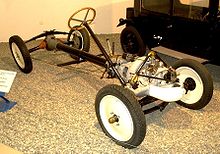
Back Páteřový rám Czech Zentralrohrrahmen German Chasis de túnel central Spanish Keskusputkirunko Finnish Châssis central French


Backbone tube chassis is a type of automobile construction chassis that is similar to the body-on-frame design. Instead of a two-dimensional ladder-type structure, it consists of a strong tubular backbone (usually rectangular in cross section) that connects the front and rear suspension attachment areas. A body is then placed on this structure. It was first used in the English Rover 8hp of 1904 and then the French Simplicia automobile in 1909.[1]
The backbone chassis was extensively developed by Hans Ledwinka who used it in greater numbers on the Tatra 11 and subsequent vehicles. Ledwinka later used backbone frames with central tube and axles with swinging driveshafts on Tatra trucks, becoming known as Tatra-concept.[2][1]
- ^ a b Pfeffer, Prof Dr Peter E. (2017). 8th International Munich Chassis Symposium 2017: chassis.tech plus. Springer. p. 176. ISBN 9783658184599.
- ^ Cite error: The named reference
ledwwas invoked but never defined (see the help page).